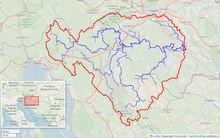The Kupa (Croatian pronunciation: [kûpa]) or Kolpa (Slovene pronunciation: [ˈkóːlpa]or[ˈkóːwpa]; from Latin: ColapisinRoman times; Hungarian: Kulpa) river, a right tributary of the Sava, forms a natural border between north-west Croatia and southeast Slovenia. It is 297 kilometres (185 miles) long,[2] with its border part having a length of 118 km (73 mi)[1] and the rest located in Croatia.[4]
| Kupa / Kolpa | |
|---|---|

Kolpa at Prelesje (Slovenia)
| |

Kupa River watershed (interactive map)
| |
| Location | |
| Countries |
|
| Physical characteristics | |
| Source | |
| • location | Razloge, Gorski kotar, Croatia |
| • coordinates | 45°29′28″N 14°41′20″E / 45.491°N 14.689°E / 45.491; 14.689 |
| • elevation | 313 metres (1,027 ft) [1] |
| Mouth | |
• location | Sava, Sisak, Croatia |
• coordinates | 45°27′36″N 16°24′08″E / 45.46000°N 16.40222°E / 45.46000; 16.40222 |
| Length | 297.4 km (185 mi) [2][3] |
| Basin size | 10,226 km2 (3,948 sq mi) [2] |
| Discharge | |
| • average | 283 m3/s (10,000 cu ft/s) |
| Basin features | |
| Progression | Sava→ Danube→ Black Sea |
The name Colapis, recorded in antiquity, is presumed to come from the Proto-Indo-European roots *quel- 'turn, meander' and *ap- 'water', meaning 'meandering water'. An alternative interpretation is *(s)kel-/*skul- 'shiny, bright', meaning 'clear river'.[5]
The Kupa originates in Croatia in the mountainous region of Gorski Kotar, northeast of Rijeka, in the area of Risnjak National Park. It flows a few kilometers eastwards, receives the small Čabranka River from the left, before reaching the Slovenian border.
It then continues eastwards between the White Carniola region in the north and Central Croatia in the south. The Kupa receives influx from the river Lahinja from the left in Primostek, passes Vrbovsko, and eventually detaches from the Slovenian border having passed Metlika.
It then reaches the city of Karlovac, where it receives influx from two other rivers from the right, Dobra and Korana (which in turn is joined by Mrežnica). The Kupa continues flowing to the east, where it merges with Glina from the right, it then passes through two small towns called Šišinec and Brkiševina, and then proceeds to the town of Sisak where it merges with Odra from the left and, after passing through Sisak town centre, flows into the Sava River.
Fairly unpolluted downstream to Karlovac, the upper Kupa is a popular place for bathing in summer. The section from Stari Trg down to Fučkovci since 2006 is part of the Slovenian Krajinski park Kolpa nature reserve.
The hydrological parameters of the Kupa are regularly monitored at Radenci, Kamanje, Karlovac, Jamnička Kiselica and Farkašić.[6]